
Navigating junctions is a critical aspect of learning to drive and is heavily emphasized during the driving test. The practical driving test is designed to cover a wide range of road scenarios, and junctions are a key component of this.
Driving examiners will assess your ability to handle various junctions, ensuring you are thoroughly tested on your driving skills. Becoming a fully qualified driver is no small feat, and mastering junctions is an essential part of the journey.
- Road Junctions
- T-Junctions
- Y-Junctions
- Crossroads
- Staggered Junctions
- Roundabouts
- Ways in Which Junctions Can Differ
- Signs Related to Junctions
- How to Deal with Junctions
- What Are Examiners Looking for at Junctions?
- Frequently asked questions
To pass your driving test confidently, it’s vital to understand how to deal with junctions correctly. This guide will take you through the different types of junctions you might encounter during your test. You’ll learn how to identify them and approach them safely.
In addition to the basics, we’ll also provide some extra tips and advice to help you make a positive impression on your examiner. By mastering the approach to various junctions, you’ll be well on your way to becoming a competent and safe driver.
Road Junctions
For anyone learning to drive, it quickly becomes clear that the term ‘junction‘ encompasses a variety of road features where roads intersect or join together.
It’s not just a single type of road feature but a term that covers a range of different scenarios on the road. Understanding and navigating these junctions is a crucial skill for any aspiring driver.

Image source: Open Government Licence v3.0
T-Junctions
T-junctions are among the most frequently encountered types of junctions on the road. As the name suggests, these junctions occur where one road meets another in the shape of the letter ‘T’.
T-Junctions can vary significantly in their characteristics. They might be governed by ‘stop’ or ‘give way’ signs, and sometimes there are minimum or maximum speed limits indicated. The presence of road markings at T-junctions can also vary, often depending on their location.
When preparing for your practical driving test, it’s almost certain that you’ll come across T-junctions. These junctions are a common feature on both major and minor roads, making them an essential aspect of driving to master.

Image source: Wikimedia Commons
Y-Junctions
Y-Junctions are another common type of junction you’ll encounter on the roads. Named for their shape that resembles the letter ‘Y’, these junctions usually involve a major road continuing straight ahead, with a minor road joining it at an angle.
Similar to T-junctions, the presence of road markings at Y-junctions can vary, and these markings (or lack thereof) often depend on the junction’s location. These markings are important as they can indicate the priority of the roads converging at the junction.
You’re likely to come across Y-junctions during your practical driving test. They are found in a variety of settings, including minor roads and dual carriageways.
While Y-junctions also exist on motorways, it’s important to note that motorways are not included in the practical driving test. Understanding how to navigate Y-junctions safely and confidently is an essential skill for any learner driver.

Image source: Open Government Licence v3.0
Crossroads
Crossroads are intersections where two or more roads cross each other. While they may seem straightforward, crossroads can be quite hazardous, especially when unmarked. It’s important to exercise caution at all times, whether the crossroads are marked or controlled.
For your driving test, you’ll likely encounter crossroads along your route. As such, it’s essential to prepare adequately. Pay particular attention to other road users, including pedestrians and cyclists, who may be crossing or using these junctions. Being vigilant and aware at crossroads is key to safe driving.
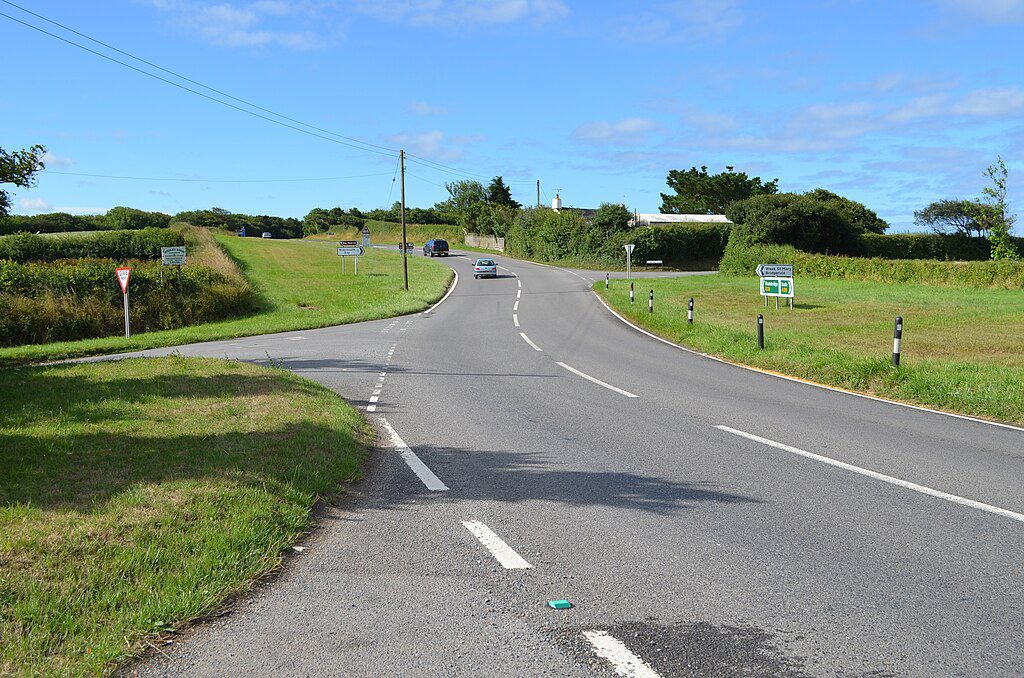
Image source: Wikimedia Commons
Staggered Junctions
Staggered junctions are a variation of crossroads, with the key difference being that the intersecting roads are offset from each other. Generally, at a staggered junction, a minor road meets a major road and then continues onto another minor road a short distance away.
In the absence of traffic lights, you will usually find ‘give way’ or ‘stop’ signs to help manage the flow of traffic and indicate priority at these junctions.
If you encounter a staggered junction during your driving test, it’s important to exercise caution with your road positioning and signalling. Navigating these junctions safely requires clear communication with other road users and an understanding of the right-of-way rules.
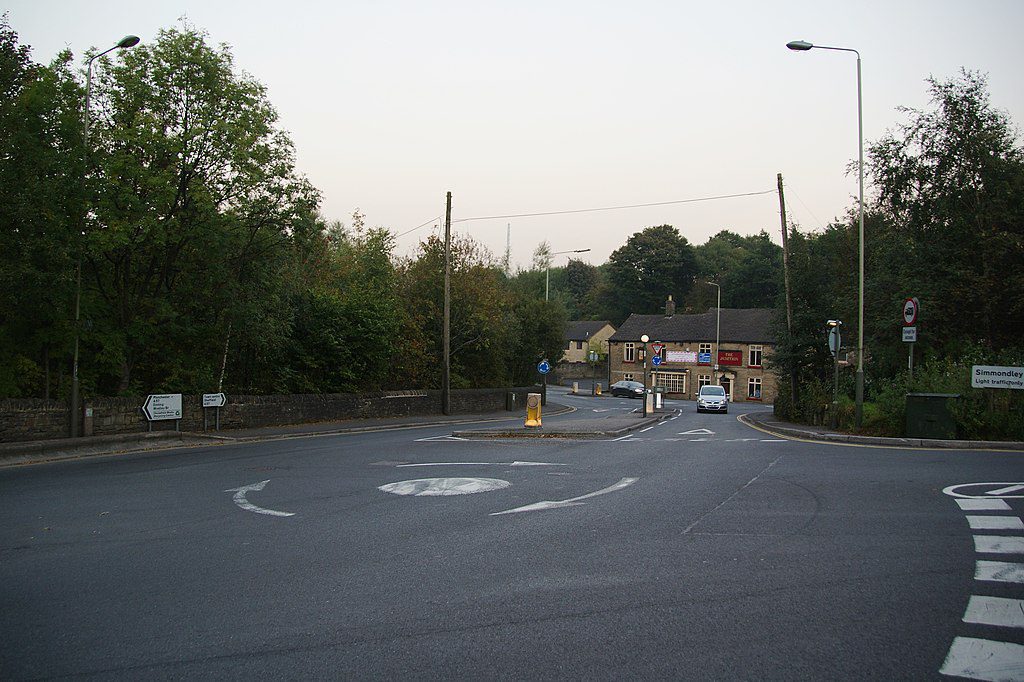
Image source: Wikimedia Commons
Roundabouts
Roundabouts often pose a challenge for learner drivers, yet they are an essential type of junction to master. Recognizing roundabouts as junctions is key to understanding how to navigate them correctly.
As you approach a roundabout, you’ll typically be given ample warning through road signs, guiding you on how to enter and exit safely.
Given the prevalence of roundabouts in many areas, it’s highly likely that you’ll encounter them during your driving test. If you feel uncertain about handling roundabouts, it’s a good idea to familiarise yourself with the different types of roundabouts and their specific rules.
This preparation can significantly boost your confidence and competence in tackling roundabouts during your test.
Ways in Which Junctions Can Differ
Junctions are a fundamental aspect of road navigation, but they come in various forms, each presenting its unique challenges and rules. Let’s explore the different types of junctions you might encounter.
Open Junctions
Open junctions provide a clear, unobstructed view of the road ahead, allowing drivers to quickly assess whether it’s safe to proceed. In many cases, if the way is clear, you can simply slow down, shift gears, and continue without stopping.
Closed Junctions
In contrast, closed junctions offer a limited view of the road, often due to obstacles like trees or signposts. Here, drivers need to slow down significantly or come to a complete stop to safely check for traffic before emerging.
Blind Junctions
Blind junctions are more challenging, offering no clear view of the approaching road. Drivers must stop completely and then edge forward cautiously to gauge whether it’s safe to proceed.
Marked Junctions
Marked junctions come with helpful road markings indicating traffic flow and priorities. These markings, along with accompanying ‘stop‘ and ‘give way‘ signs, guide drivers on where to stop and how to navigate the junction.

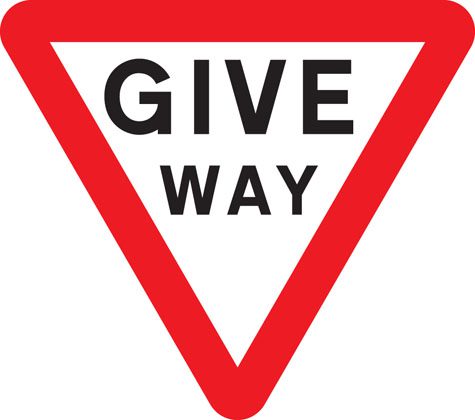
Unmarked Junctions
Unmarked junctions lack visible road markings and are often found in quieter, rural areas. Without clear priority rules, these junctions require extra caution and negotiation with other road users.
Box Junctions
Box junctions feature a distinctive yellow box with criss-cross lines. The rule here is not to enter the box unless your exit road is clear. While they often have traffic lights, this isn’t always the case. It’s essential to understand the specific rules governing box junctions.
Controlled Junctions
Controlled junctions, typically found in busy areas, are regulated by traffic lights. They may have multiple lanes and designated areas for cyclists. Pay attention to filter lights and be ready to move off promptly to avoid traffic delays.
When preparing for your driving test, familiarising yourself with these different types of junctions is crucial. Understanding how to approach and navigate each type safely will not only help you pass your test but also ensure your ongoing safety on the road.
Remember, effective junction handling involves good observation, clear signalling, and correct positioning.
Signs Related to Junctions
Recognising and understanding signs related to junctions is a crucial skill for any driver, especially for those preparing for a driving test. Successfully navigating through junctions often depends on your ability to spot these signs early.
While not every junction is preceded by clear signage, most of the busier ones are marked with distinct road signs. Being alert and aware of these signs can significantly enhance your readiness to approach and navigate junctions safely.
For both experienced drivers looking for a refresher and learners solidifying their knowledge, familiarising yourself with the main types of junction signs is essential. These signs provide valuable information about the type of junction ahead and the appropriate actions to take, ensuring a smoother and safer driving experience.
Give Way Sign

T-Junction Sign
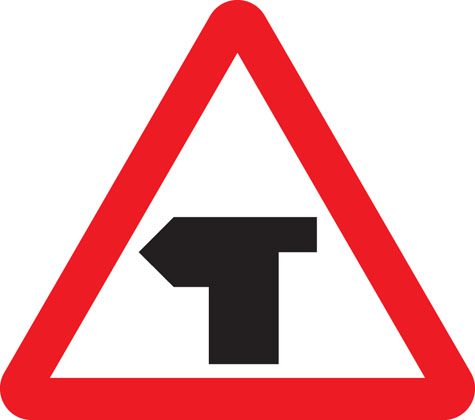
Crossroads Sign
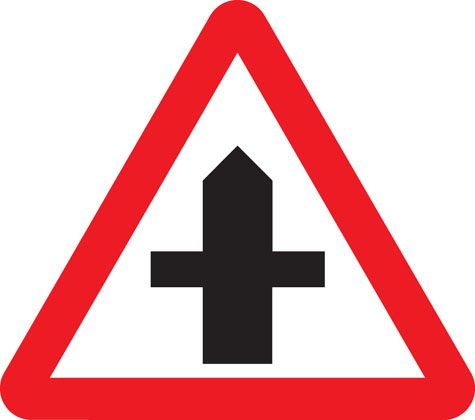
Staggered Junction Sign
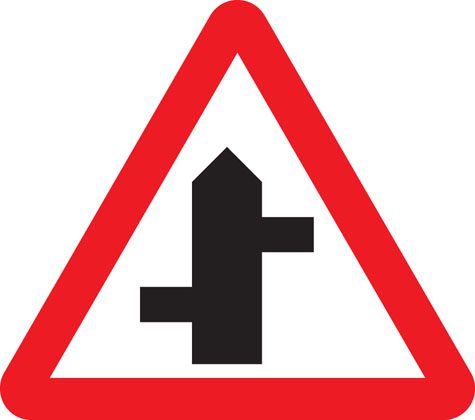
Junction on Left Bend Sign
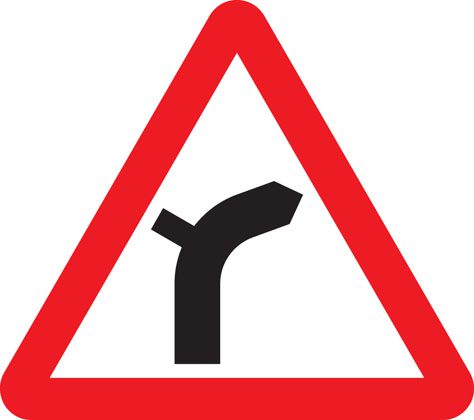
Junction on Right Bend Sign
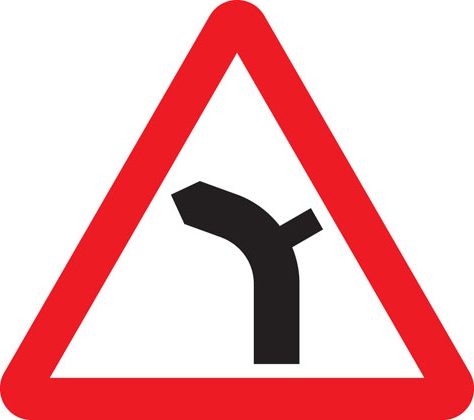
Left Side Road Ahead Sign
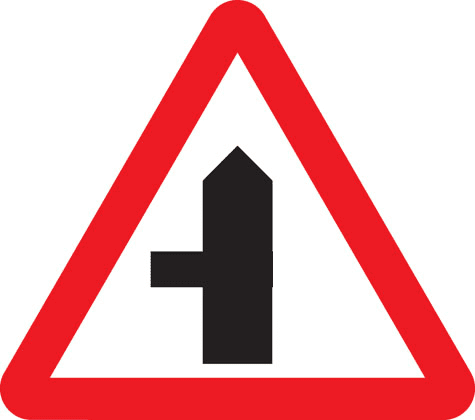
Right Side Road Ahead Sign

Stop Line 100 yards Junction Sign

Give way 50 yards junction sign
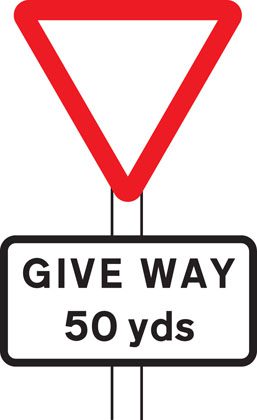
How to Deal with Junctions
Navigating junctions is a key skill in driving, and it’s important to approach them with the right technique and awareness. Here’s a step-by-step guide to help you handle junctions confidently.
Spotting Junctions Early
First and foremost, identifying a junction in advance is crucial. Many learner drivers accrue faults in their driving tests by noticing junctions too late. Early detection is a fundamental aspect of hazard perception.
Keep an eye out for road signs and markings, or watch for traffic slowing down ahead, which can indicate an upcoming junction.
Performing Checks
Before approaching a junction, the mirror-signal-manoeuvre (MSM) routine is essential. This routine ensures you’re making informed decisions based on the traffic situation:
- Interior Mirror: Start with a quick glance at your interior mirror to assess the traffic behind you.
- Side Mirrors: Then, check your left or right mirror, depending on your direction of turn.
- Indicators: Use your turn signal to inform other road users of your intended action.
Taking Action
Proper road positioning is key when approaching a junction:
- For a left turn, you usually won’t need to adjust your position significantly.
- For right turns, position your car closer to the centre of the road. Be extra cautious, as this involves crossing the path of oncoming traffic.
At an open junction with a clear view, you might simply need to downshift and proceed. At a busy or closed junction, come to a complete stop and wait for a safe opportunity to continue.
Blind Junctions
At blind junctions, where visibility is limited, edge out slowly and cautiously to check for approaching traffic.
Post-Junction Checks
Even after navigating the junction, it’s important to continue checking your mirrors. Be on the lookout for pedestrians, cyclists, and other vehicles as you join the new road. It’s vital to blend into the traffic flow promptly without causing disruption.
Remember, consistent practice and awareness are key to mastering junctions. Each type of junction presents its own challenges, but with the right approach and thorough preparation, you can navigate them safely and confidently.
What Are Examiners Looking for at Junctions?
Passing the driving test often hinges on how well you handle junctions. Examiners are not out to fail you; they’re assessing your ability to safely navigate junctions. Here’s what they typically focus on:
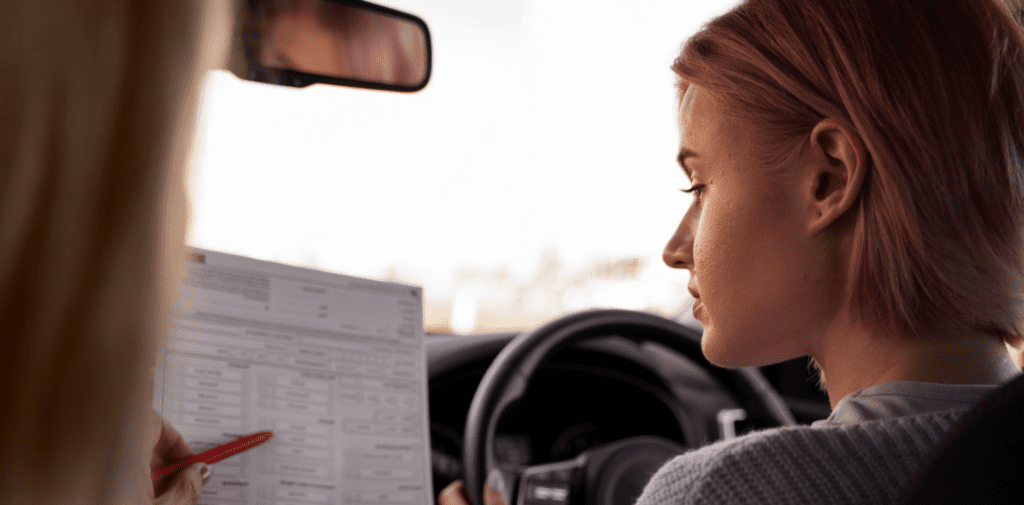
Approach Speed
Approaching a junction at the right speed is crucial. Coming in too fast suggests lack of control, while being overly slow can indicate hesitancy. The key is to slow down smoothly as you near the junction, adjusting your gear if necessary. This demonstrates control and readiness to react to road conditions.
Observations
Effective observation is a common stumbling block for learners, but it’s also one of the most important aspects at junctions. You need to consistently use the mirror-signal-manoeuvre (MSM) routine and be vigilant for other road users like cyclists, motorcyclists, and pedestrians. Regular mirror checks and being aware of road signs and markings approaching a junction are essential.
Turning Left or Right
Correct road positioning when approaching a junction is vital. If you’re turning right but positioned too far to the left, you might block other vehicles. Proper positioning is needed well in advance of the turn.
Cutting Corners
Be cautious not to cut corners or mount the pavement, as this can lead to major faults. To avoid this, ensure you’re driving slowly enough to control your steering effectively, ideally in second gear or lower.
In summary, examiners are looking for safe, controlled, and confident handling of junctions. This includes appropriate speed, vigilant observations, correct positioning, and smooth steering. Mastering these elements not only helps you pass your driving test but also sets a foundation for safe driving practices in the future.
Frequently asked questions
Whether or not you need to stop at a junction depends on the road signs present. If there’s a ‘Stop‘ sign, you must come to a complete stop every time. Ignoring this sign during your driving test will lead to a fail.
In situations where there isn’t a ‘Stop’ sign, you can proceed onto the road ahead if it’s clear and safe to do so. However, during your driving test, it’s advisable to err on the side of caution.
Unless you’re absolutely certain that the road is clear, it’s better to come to a stop before proceeding. This approach demonstrates to the examiner that you’re taking a safe and careful approach to junctions.
The appropriate speed to approach a junction varies depending on several factors. If the junction is open and the road ahead is clear with no obstructions or vehicles, you can approach and emerge from the junction in second gear. This allows for a smooth transition without needing to stop.
However, if there are vehicles ahead of you or if the visibility of the road is unclear, it’s safer to slow down to first gear and prepare to stop. This approach ensures you have ample time to assess the situation and make a safe decision before proceeding. It’s always better to be cautious at junctions, prioritising safety over speed.
At an unmarked crossroads, no driver inherently has the right of way. This lack of clear priority is what can make these junctions particularly challenging and potentially hazardous. In the absence of road signs or markings, drivers need to rely on their judgment and common sense to determine when it’s safe to proceed.
Rather than assuming you have the right of way, it’s crucial to conduct thorough observations and patiently wait until the road is clear before moving forward. In such situations, erring on the side of caution is the best approach. Remember, it’s always preferable to prioritise safety over speed or convenience at unmarked crossroads.
Under the rules of the Highway Code, pedestrians have the right of way at junctions if they have already started crossing the road that a driver is turning into. In this situation, drivers are required to give way to pedestrians.
However, if pedestrians are still waiting to cross, the driver has priority. While it might seem courteous to stop and let waiting pedestrians cross, it’s important to consider the behaviour of oncoming traffic.
Stopping unexpectedly could potentially create a hazardous situation, especially if other drivers aren’t prepared to stop. Therefore, it’s crucial to balance courtesy with safety, adhering to the rules and ensuring the well-being of all road users.
In the driving test, faults are categorized into two types: major faults (also referred to as ‘serious’ or ‘dangerous’) and minor faults. If you commit any major faults, you will automatically fail the test.
However, when it comes to minor faults, you are allowed some leeway. You can accumulate up to 15 minor faults and still pass the test, earning your full driving licence. It’s important to note, though, that accumulating too many minor faults in the same category could be considered a major fault, leading to a fail.
So, while minor faults are less severe, it’s still crucial to aim for as few faults as possible for a successful test result.
When tackling junctions in your driving test, there are several common mistakes you should strive to avoid.
First and foremost is inadequate observation. Failing to properly look around and use your mirrors before making a move is a frequent error among learners. Ensuring thorough observation is key to safely navigating junctions.
Other mistakes to be wary of include:
-
Approaching Junctions at Incorrect Speeds: Approaching a junction too quickly can be seen as reckless while approaching too slowly might be interpreted as hesitancy or lack of confidence. Finding a balance is crucial.
-
Cutting Corners: This not only shows poor control but can also be dangerous. Ensure you stay in your lane and make a full turn without crossing into other lanes or onto pavements.
-
Poor Road Positioning: When turning left or right at a junction, your road positioning should indicate your intended direction and not impede other road users.
Avoiding these mistakes will demonstrate to the examiner that you have the skills and confidence to handle junctions safely, which is a crucial part of driving.
Yes, signalling at junctions is a must.
It’s crucial to communicate your intentions to other road users. As you approach a junction, always follow this sequence: first, check your mirrors to assess the traffic situation around you.
Then, signal well in advance to indicate your intended direction. After signalling, adjust your speed appropriately, and finally, decide to either stop or proceed (if the junction is open and clear).
Not signalling at a junction during your driving test will almost certainly result in a fault being recorded by the examiner. It’s a key aspect of safe and considerate driving.
No, you should not stop in the cyclist waiting area at junctions.
This area is specifically designated for cyclists. When approaching traffic lights that have a reserved area for cyclists, you need to stop at the first white line, not in the cyclist area.
Once the lights turn green, you may proceed, but ensure you give way to any cyclists who are already in the cyclist waiting area or moving ahead of you. Respecting these areas is important for the safety of cyclists and helps maintain smooth traffic flow at junctions.


